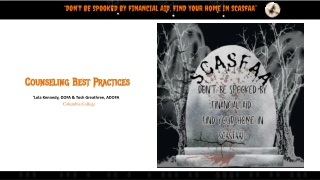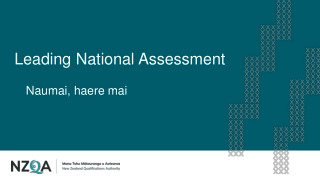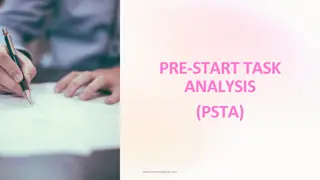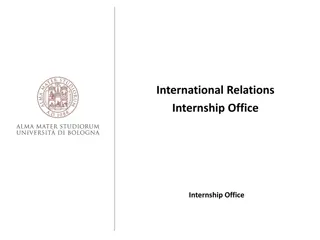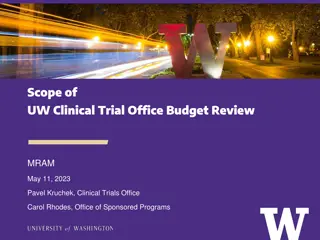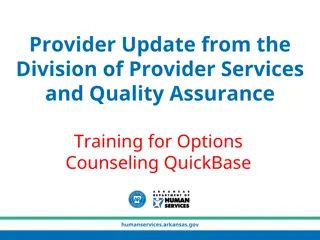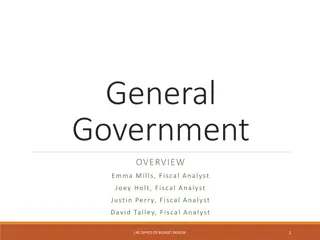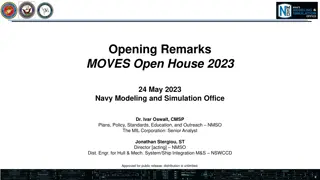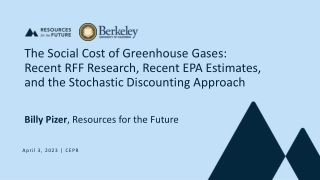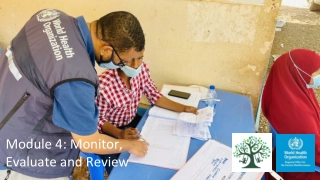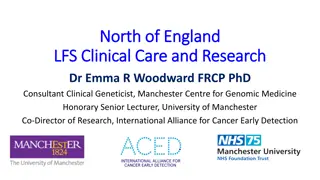Efficient Approach to Assessing Syncope in Office Practice
Dr. Vu Kiet Tran discusses an efficient approach to assessing syncope in office practice, focusing on risk factors for sudden cardiac death, the use of ECG and CT scans, and differential diagnosis to identify cardiac causes of syncope. Through case studies and learning objectives, key aspects of syncope evaluation are highlighted.
Download Presentation
Please find below an Image/Link to download the presentation.
The content on the website is provided AS IS for your information and personal use only. It may not be sold, licensed, or shared on other websites without obtaining consent from the author. Download presentation by click this link. If you encounter any issues during the download, it is possible that the publisher has removed the file from their server.
Presentation Transcript
An Efficient Approach to Assessing syncope in Your Office Dr. Vu Kiet Tran, MD, FCFP(EM), MHSc, MBA, CHE, ICD.D
Learning Objectives 1. Identify the risk factors for sudden cardiac death. 2. Analyze the evidence surrounding the use of ECG and CT scans in the assessment of the patient with syncope. 3. Perform a differential diagnosis to identify or rule-out cardiac causes of syncope.
75 yo female presents with syncope Multiple previous episodes PMH: CAD, CABG, DM Physical exam normal ECG: LBBB She is well in your ED What will be management?
Young female of 28 yo. Felt weak in the subway station Then passed out as she tried to get up from her seat Now in your clinic What work-up would you like?
Sudden transient loss of consciousness with concurrent diminution in postural tone followed by spontaneous recovery, and absence of neurological sequelae vs pre-syncope (near-syncope)
Definition Greek origin synkoptein meaning to cut short , pause Sudden transient loss of consciousness with concurrent diminution in postural tone followed by spontaneous recovery, and absence of neurological sequelae. vs pre-syncope (near-syncope)
Syncope and Syncope Symptom Conditions Syncope Chest pain Aortic dissection Ruptured AAA STEMI Acute PE Syncope Headache SAH Intra-parenchymal hemorrhage Syncope Shortness of breath Pneumothorax PE Syncope Abdo pain Ruptured AAA Ruptured viscous Syncope Bleeding UGIB LGIB Syncope Rash Anaphylaxis Sepsis
Syncope and nothing else
TIA What is not Stroke (ischemic or hemorrhagic) Syncope!!! Hypoglycemia
Seizures Drop-attacks Syncope mimics Conversion syndromes Psychogenic syncope Malingering
Aborted Sudden Cardiac Death = Syncope
Sudden Cardiac Death Malignant Ventricular arrhythmias WPW Long QT Syndrome Short QT Syndrome Brugada Syndrome ARVC Catecholaminergic VT
A given opportunity to diagnose a potentially fatal disease and prevent sure death in a patient who is currently feeling well and unaware of his fate
Epidemiology 3-5% of ED visits (1-2 million) 1-6% of hospital admissions Diagnosis in only up to 70-80% No cause on initial evaluation 34% Most causes are benign Mortality low Cardiac origin: 18-33%
Incidence Bimodal distribution (10- 30yo and > 65yo) Rates increase with age (sharp rise at 70 yo) Lifetime cumulative incidence (subjects > 65yo): 35-39% 80% have their first episode before age of 30y
In General Practice Prevalence is 2-9 per 1000 encounters Peak ages 10-30yo (women) Age > 65 (both men and women) Only a subgroup presents to a medical doctor 44% did not seek medical advice Event rate is 2-4 times higher in the general population than the presentation rate
In General Practice More frequent in women Young men tend not to visit their GP Elderly tend to visit their GP in relation to the younger patient (22 vs 2 visits/1000pt-years)
Incidence Incidence doubles with Hx of cardiac disease NEJM 2002; 347: 878-885
Mortality according to etiology
Etiologies Vasovagal 20% Cardiac 13% Orthostatic hypotension 9% Medications 7% Stroke 4% TIA 4% Other 10% Unknown 31% NEJM 2002; 347: 878-885
My classification Non-fatal Fatal Vasovagal Cardiac arrhythmias (and medications) Orthostatic hypotension (and medications) Hemorrhage Psychogenic Sepsis/shock
Question 1 What contributes the most to arriving at a diagnosis of causes of syncope? A. B. C. D. E. CT scan of the head Holter monitor ECG Lab tests History and physical exam
Question 1 What contributes the most to arriving at a diagnosis of causes of syncope? A. B. C. D. E. CT scan of the head Holter monitor ECG Lab tests History and physical exam
Question 2 With a good clinical assessment (history and physical exam only), what is your diagnostic yield? A. B. C. D. E. 10% 20-25% 45-50% 65-70% I really don t care. I just want to order that CT head!
Question 2 With a good clinical assessment (history and physical exam only), what is your diagnostic yield? A. B. C. D. E. 10% 20-25% 45-50% 65-70% I really don t care. I just want to order that CT head!
History Physical Exam ECG History Physical Exam ECG
Core work-up History Physical exam ECG
First step History, physical exam, and ECG form the cornerstone of initial evaluation Diagnostic yield of 45-50% Ann Int Med 1997; 126: 989-996
Question 3 Which element of the story in the assessment of syncope is NOT contributory? A. Medication list B. Context in which the syncope occurred C. Family History of sudden death D. Medical history of Diabetes E. Persistent of hemi-lateralization
Question 3 Which element of the story in the assessment of syncope is NOT contributory? A. Medication list B. Context in which the syncope occurred C. Family History of sudden death D. Medical history of Diabetes E. Persistent of hemi-lateralization
Painful History Did the patient have syncope? Dizziness/vertigo? Drop attack? (no LOC) Seizure activity Falls Sequence of events: Context Prodrome (and duration of prodrome) During the event After the event Neurologic symptoms
History Plays a key role in the initial evaluation of syncope Prodromal symptoms Family history Triggers and context Medications Europace (2009) 11, 937-943
History 20 symptoms were assessed Outcomes: recurrence of syncope or death Factors that risk stratify: Age Previous syncopal episodes Psychiatric history Baseline heart disease Abnormal ECG Ann Intern Med. 1997; 126: 989-996
Historical independent predictors of an abnormal EPS AGE LVEF < 0.40 (CHF) STRUCTURAL HEART DISEASE Ann Noninvasive Electrocardiol 2009; 14(2): 119-127
Age over 65 Congestive heart failure Existing heart disease Family history of SCD Abnormal ECG
Am J Med 2001. 111: 177-84 Ann Intern Med, June 15 1997; 126 (12): 989-996 Low diagnostic yield: 5% A normal ECG is highly predictive of benignity In the absence of an abnormal ECG, further cardiovascular testing has little yield ECG are non-invasive, easy to perform, and inexpensive Abnormal ECG in 82% of patients who died in follow- up ECG
Further testing provides very little yield Except for paroxysmal arrhythmias Paroxysmal high grade AV heart blocks (elderly patients) Normal ECG
Things to look for on ECG Arrhythmias/blocks Ischemias PE Short PR/LGL/WPW Long QT Syndrome Short QT Syndrome ARVD Brugada Syndrome HCOM Pulmonary hypertension
History and ECG ECG in addition to history and physical exam yielded a diagnosis in 76% of cases Am J Med 2001; 111: 177-184
Ann Intern Med, June 15 1997; 126 (12):989-996 Basic RBW Diagnostic yield: 2-3% usually confirms a clinical suspicion not recommended, should be guided by clinical evaluation Pregnancy test is recommended in all women of child- bearing age laboratory testing
D-Dimer (Euro J Emerg Med 2009. 16: 256-260) Not so useful labs Myoglobine and CK (Euro J Emerg Med 2009. 16: 84-86)
Ann Intern Med, June 15 1997; 126 (12): 989-996 Diagnostic yield 5-35% Echocardiography Stress testing Holter Loop recorder EPS Cardiac testing
Heart 2002; 88: 363-367 Ann Intern Med July 1 1997; 127 (1): 76-86 Low yield 5-7% Routine Echo did not establish the cause of the syncope Normal Echo for ALL patients without a cardiac history and normal ECG Important if presence of structural heart disease or abnormal ECG Echocardiography
Echo EC G
Exercise stress testing Low yield: < 1% Indicated in: Ischemic heart disease Exertional syncope* Ann Inter Med July 1 1997; 127 (1): 76-86
24 Holter Yield of 19% 4% correlation of symptoms with arrhythmia 15% have symptoms without arrhythmia 14% have asymptomatic arrhythmia Causal relation between most of these arrhythmias and syncope is uncertain A negative holter does not r/o arrhythmogenic etiology Ann Inter Med July 1 1997; 127 (1): 76-86
External Loop recorder Yield 24-47% (highest in patients with palpitations) Indications 1) Frequent episodes with normal heart 2) Recurrent events








